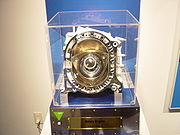
About electric cars
Electric cars have been around for a very long time, but the use of such cars have yet not taken off due to difficulty with storing large amounts of energy in batteries and due to long loading time.
Electric cars have certain advanages.
They are for example not polluting the near surroundings. These advantages go away in a larger scale or even reversed, however, it the electricity is produced in oil heated or worse, coal-heated power plants. Therefore this advanage is only real when the electricity is produced in hydro-electric power planst, by solar cell panels or by wind power.
Electric cars have an echonomical advantage at places where energy from electrcity is cheaper than petrol or diesel carried energy. This advantage is even stronger for farmers and housholds that produce their own electrcity by wind-power or by solar cell panels.
They have a great security advantage it that they do not carry combustible fuel.
The battery techology is gradually improving and the storage capacity will gradually approach that of combustion engine driven vehicles.
The disadvantage that is expected to ramain is slow loading time. It will never be possible to load an electric car in the same time that one ca load a combustion fuel driven car, without some very special techiques where the whole battery is shifted with a fully loaded one with some automatic device at the loading station.
The battery technology is not so environmentally friendly either, since batteries conatin poisonous substanses like cadmium.
In areas where electricity is produced environmentally friendly, electric cars will also get a strong competitor, namely hydrogen driven cars. The electrcity can be used to make hydrogen and hydrogen can easily be loaded like petrole or diesel. Hydrogen carries however a fire safety risk, like other combustible fuels.
One might wonder if electric cars will be commonly used like perol driven cars and diesel driven cars.
They will definitely be the best solution for users that have a cheap source of electricity or have a more easy eccess to electricty that combustible fuel and for whome long loading time is not any problem.
Those users will howver worldwide be only some percent of the total numbers of car owners. Therefore cars driven by electric montors and loaded by electricity will only have a certain share of the market.
Electric motors can however be used in cars in other smart ways. It is for example possible to have electric motors integrated in the wheels.
Such a system avoids complicated mechanic transmissions and posible also avoids a gearbox, and makes the total layout of the car simpler.
By a smart controle of the motor power in each wheel, dynamic traction controle of various kind for driving safety and to maximize grip can easily be achieved.
By such a traction system the electricity can come from a battery or a combustion engine can drive a generator that makes electricity for those motors.
In such a layout, electric cars and cars powered by combustion engines can be constructed with the same basic layout, an only different energy sources can be set in.
About Wankel motors
A Wankel engine (also called rotary engine) is a gasoline engine designed by the German engineer Felix Wankel in the 1950s.
In a conventional piston engine makes the pistons in the cylinders four different tasks after one another - intake, compression, combustion and exhaust. I
In a Wankel engine a rotating triangle placed in the motor block makes these
four tasks at once. The rotation is transferred to a gear that sits on the drive
axle in the middle of the block and which the triagle is rotating around.
Wankel engine was used by NSU in the car NSU Spider from 1964 - and later in the
NSU Ro 80 - but due to technical problems it was not a success. Mazda still uses
the engine in sports cars such as Mazda RX-7 and Mazda RX-8.
Benefits
The Wankel engine has only two moving parts. Therefore it needs little
maintainance. The triangle in a Wankel engine moves more continuously (not
accelerated as much back and forth) as pistons in reciprocating engines,
which allows Wankel engine to withstand extremely high speeds, often up to 13
000 revolutions per minute.
Power = torque * rpm. So Wankel engine can provide a lot of power in relation to
stroke volume, particularly weight.
Disadvantages
The wankel engine of geometrical reasons not have as high compression as gasoline engines. It therefore provides lower torque and consequently lower efficiency than other gasoline engines.
Every corner of the triangle must have contact with the walls to separate the three volumes that are between the walls and each edge of the triangle. At these contacts will make friction and it is therefore mounted a spring-loaded "Apex" metal that can be replaced when worn. This was, and remains the Wankel engine's biggest problem. Because of this, the Wankel engines have shorter life than piston engines. Maintenance is however easier
A Wankel engine from Mazda ( A free to copy picture from wikipedia.org)
